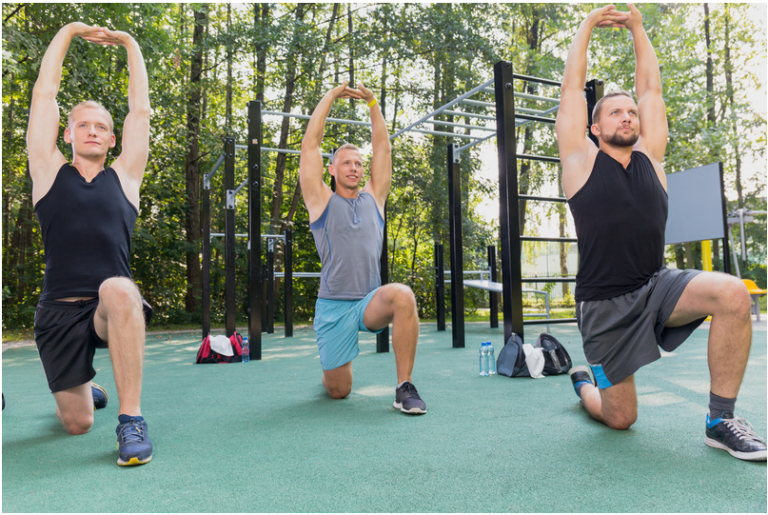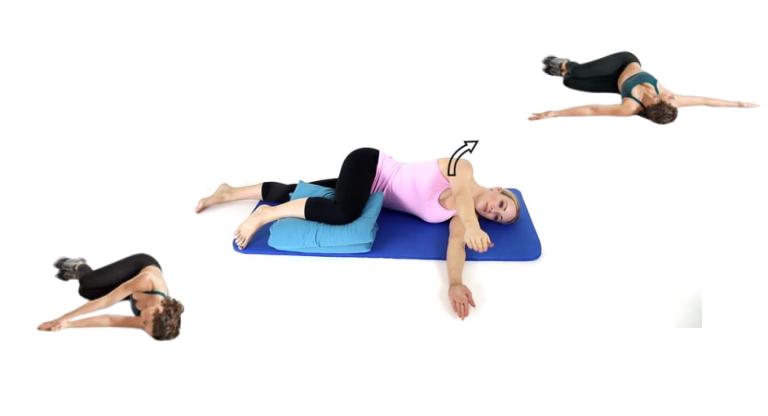
How Stretching Trapezius Muscle Can Loosen Up Your Neck and Shoulders

Do you often feel tightness and pain in your neck and shoulders? Do you suffer from headaches, back pain, or muscle spasms? If you answered yes to any of these questions, you may have a problem with your trapezius muscle.
The trapezius muscle, or trap for short, is a large, superficial muscle that extends from the base of your skull to the middle of your back and from your spine to your shoulder blade. It is responsible for moving, stabilizing, and supporting your neck, shoulders, and upper back.
The trap can become tight, tense, and sore due to various causes, such as poor posture, stress, overuse, injury, or muscle strain. A tight trapezius can affect mobility, posture, and quality of life. It can also lead to other problems, such as trigger points, muscle spasms, headaches, and lower back pain.
Fortunately, there are some simple and effective ways to stretch your traps and loosen up your neck and shoulders. Stretching your trapezius muscle can help relieve tightness and pain, improve your posture and range of motion, and prevent further injury. In this article, we will show you some of the best trapezius stretches you can do at home or work, as well as some tips and precautions to keep in mind.
What is the trapezius muscle, and what does it do?

The trapezius muscle is a large, flat, triangular muscle that covers most of your upper back and neck. It is divided into three parts: the upper, middle, and lower trapezius. Each part has a different function and movement.
The upper trapezius is the part that runs from the base of your skull to your shoulder. It helps you shrug your shoulders, tilt your head to the side, and rotate your head.
The middle trapezius is the part that runs from your neck to the middle of your back. It helps you squeeze your shoulder blades together and lift your arms to the side.
The lower trapezius is the part that runs from the middle of your back to the lower end of your shoulder blade. It helps you lower your shoulders and raise your arms above your head.
The trapezius muscle works with other muscles, such as the deltoids, rhomboids, and levator scapulae, to stabilize and move your scapula or shoulder blade. The scapula is a flat, triangular bone that connects your arm to your torso. It plays a vital role in your shoulder and arm movements, such as lifting, reaching, throwing, and pulling.
The trapezius muscle also helps support your head and neck, which are very heavy and require a lot of strength and stability. The trapezius muscle helps you stay upright, turn your head, and nod.
What causes trapezius tightness and pain?

There are many possible causes of trapezius tightness and pain, but some of the most common ones are:
- Poor posture: Sitting or standing with your head forward, shoulders rounded, and back slouched can strain your trapezius muscle greatly. This can cause it to become tight, weak, and imbalanced. Poor posture can also affect your breathing, circulation, and digestion.
- Stress and tension: When stressed, anxious, or angry, you may unconsciously tense your trapezius muscle, especially the upper part. This can cause muscle cramps, spasms, and knots. Stress can also affect your sleep, mood, and immune system.
- Overuse or injury: Performing repetitive or strenuous activities that involve your neck, shoulders, and upper back can overwork your trapezius muscle and cause micro-tears, inflammation, and scar tissue. This can happen if you lift heavy objects, play sports, exercise, or work on a computer for long periods. Trauma, such as a car accident, a fall, or a blow to the head, can also injure your trapezius muscle and cause pain and stiffness.
- Muscle strain: A muscle strain is a tear or stretch of the muscle fibers or tendons that attach the muscle to the bone. A muscle strain can occur if you overstretch, twist, or contract your trapezius muscle too forcefully or suddenly. A muscle strain can cause pain, swelling, bruising, and loss of function.
- Trigger points: Trigger points are small, sensitive areas in the muscle that cause pain when pressed or stimulated. Trigger points can develop in any muscle but are especially common in the trapezius muscle. Trigger points can cause local or referred pain, meaning that the pain can spread to other body areas. For example, a trigger point in the upper trapezius can cause head, neck, jaw, or eye pain. Trigger points can also cause muscle stiffness, weakness, and a reduced range of motion.
How to Stretch Your Trapezius Muscle and Loosen Up Your Neck and Shoulders
Stretching your trapezius muscle can help you relieve tightness and pain, improve your posture and mobility, and prevent further problems. Stretching your trapezius muscle can also help you relax, breathe better, and feel more energized.
Here are some of the best trapezius stretches you can do at home or work. For some of these stretches, you will need a chair, a wall, and a massage ball. You can also use a towel, a belt, or a resistance band to substitute the massage ball.
Before you start, warm up your muscles with light movements, such as shoulder rolls, arm circles, and neck rotations. This will help you prevent injuries and increase your flexibility.
Also, remember to follow these general guidelines when stretching:
- Stretch gently and slowly. Do not bounce, jerk, or force your muscles beyond their comfortable range of motion.
- Breathe deeply and regularly. Do not hold your breath or tense up your muscles.
- Hold each stretch for 15 to 30 seconds or as long as it feels comfortable. Repeat each stretch 2 to 4 times or as needed.
- Stretch both sides of your body equally. Do not favor one side over the other.
- Listen to your body. Stop or modify the stretch if you feel pain, discomfort, or dizziness.
Upper Trapezius Stretch
The upper trapezius stretch targets the upper part of your trapezius muscle, which helps you shrug your shoulders and tilt your head to the side.
To do this stretch, follow these steps:
- Sit or stand with your back straight and your shoulders relaxed.
- Tilt your head to the right, bringing your right ear towards your right shoulder. Do not lift your shoulder or twist your neck.
- Place your right hand on the left side of your head and gently pull your head down, increasing the stretch on the left side of your neck and shoulder.
- Hold this position for 15 to 30 seconds, feeling a gentle stretch in your upper trapezius muscle.
- Release this side and repeat on the other side.
Middle Trapezius Stretch
The middle trapezius stretch targets the middle part of your muscle, which helps you squeeze your shoulder blades together and lift your arms to the side.
To do this stretch, follow these steps:
- Sit or stand with your back straight and your shoulders relaxed.
- Interlace your fingers in front of you and extend your arms at chest level.
- Round your upper back and push your arms away from your body as if you are trying to touch the wall in front of you.
- Hold this position for 15 to 30 seconds, feeling a gentle stretch in your middle trapezius muscle and between your shoulder blades.
- Release this position and relax your arms.
Lower Trapezius Stretch
The lower trapezius stretch targets the lower part of your trapezius muscle, which helps you lower your shoulders and raise your arms above your head.
To do this stretch, follow these steps:
- Sit or stand with your back straight and your shoulders relaxed.
- Raise both arms above your head and interlace your fingers, palms facing up.
- Lengthen your spine and reach your arms up as if you are trying to touch the ceiling.
- Hold this position for 15 to 30 seconds, feeling a gentle stretch in your lower trapezius muscle and along your spine.
- Release this position and lower your arms.
Trapezius massage with a ball
The trapezius massage with a ball is a self-massage technique to help you release tension and trigger points in your trapezius muscle. You can use a massage ball, a tennis ball, a lacrosse ball, or any similar object for this technique.
To do this message, follow these steps:
- Stand against a wall and place the ball between your upper back and the wall. You can also do this lying on the floor or a mat.
- Find a tender spot in your trapezius muscle, such as near the base of your neck, the top of your shoulder, or the middle of your back.
- Lean into the ball and apply gentle pressure to the spot. You can also roll the ball slightly up and down or side to side to massage the area.
- Breathe deeply, relax your muscles, and let the ball do the work. You may feel discomfort or pain, but it should not be unbearable. If it is, reduce the pressure or move the ball to a different spot.
- Stay on the spot for 15 to 30 seconds or until you feel the muscle release. You can also move your arm or head slightly to increase the release.
- Repeat this process on other spots in your trapezius muscle, such as the middle and lower parts. You can also switch sides and massage the other trapezius muscle.
- After the massage, stretch your trapezius muscle again to enhance the benefits.
Tips and Precautions for Stretching Your Trapezius Muscle
Stretching your trapezius muscle can help you loosen up your neck and shoulders, but you should also be aware of some tips and precautions to ensure you do it safely and effectively.
- Stretch your trapezius muscle regularly, especially if you have a sedentary lifestyle, a stressful job, or a history of neck or shoulder problems. Aim for at least 2 to 3 times a week, or more if needed.
- Stretch your trapezius muscle before and after any activity that involves your neck, shoulders, and upper back, such as lifting, working on a computer, or playing sports. This will help you prevent injuries and improve your performance.
- Stretch your trapezius muscle gently and gradually. Do not force or overstretch your muscles, as this can cause more harm than good. Stop or modify the stretch if you feel sharp or severe pain, numbness, tingling, or dizziness.
- Stretch your trapezius muscle in a comfortable and relaxed position. Avoid stretching your muscles in a position that causes pain, discomfort, or strain. For example, do not stretch your neck while lying on your back, as this can compress your spine and nerves.
- Stretch your trapezius muscle in a warm and comfortable environment. Avoid stretching your muscles in a cold or draughty place, as this can make your muscles tense and tight. You can also use a heat pack, a warm towel, or a hot shower to warm up your muscles before stretching.
- Stretch your trapezius muscle in conjunction with other muscles and joints. Do not isolate your trapezius muscle, which can create imbalances and compensations. Stretch your whole body, especially your neck, shoulders, chest, back, and arms, to improve your overall posture and mobility.
- Stretch your trapezius muscle in combination with other treatments and therapies. Stretching your trapezius muscle alone may not resolve your muscle problems, especially if they are chronic or severe. You may need to consult a doctor, a physical therapist, a chiropractor, or a massage therapist for additional diagnosis and treatment. You may also benefit from other modalities, such as acupuncture, dry needling, trigger point therapy, or deep tissue massage.
Summary and Conclusion
The trapezius muscle is a large, superficial muscle that covers most of your upper back and neck. It is responsible for moving, stabilizing, and supporting your neck, shoulders, and upper back. The trapezius muscle can become tight, tense, and sore due to various causes, such as poor posture, stress, overuse, injury, or muscle strain. A tight trapezius can affect mobility, posture, and quality of life. It can also lead to other problems, such as trigger points, muscle spasms, headaches, and lower back pain.
Stretching your trapezius muscle can help you relieve tightness and pain, improve your posture and range of motion, and prevent further injury. Stretching your trapezius muscle can also help you relax, breathe better, and feel more energized.
Some of the best trapezii stretch you can do at home or work are:
- Upper trapezius stretch: Tilt your head to the side and gently pull your head down, feeling a stretch on the opposite side of your neck and shoulder.
- Middle trapezius stretch: Interlace your fingers in front of you and push your arms away from your body, feeling a stretch between your shoulder blades and along your spine.
- Lower trapezius stretch: Raise your arms above your head and interlace your fingers, palms facing up. Reach your arms up, feeling a stretch in your lower trapezius and along your spine.
- Trapezius massage with a ball: Place a ball between your upper back and a wall or the floor. Lean into the ball and apply pressure to a tender spot in your trapezius muscle. Stay on the spot for 15 to 30 seconds or until you feel the muscle release.
When stretching your trapezius muscle, make sure you follow these tips and precautions:
- Stretch your trapezius muscle regularly, especially if you have a sedentary lifestyle, a stressful job, or a history of neck or shoulder problems.
- Stretch your trapezius muscle gently and gradually. Do not force or overstretch your muscles, as this can cause more harm than good.
- Stretch your trapezius muscle in a comfortable and relaxed position. Avoid stretching your muscles in a position that causes pain, discomfort, or strain.
- Stretch your trapezius muscle in a warm and comfortable environment. Avoid stretching your muscles in a cold or draughty place, as this can make your muscles tense and tight.
- Stretch your trapezius muscle in conjunction with other muscles and joints. Do not isolate your trapezius muscle, which can create imbalances and compensations.
- Stretch your trapezius muscle in combination with other treatments and therapies. Stretching your trapezius muscle alone may not resolve your muscle problems, especially if they are chronic or severe.
You can improve your neck and shoulder health, posture, and mobility by stretching your trapezius muscles regularly and properly. You can also reduce your stress, pain, and tension and enjoy a better quality of life.
We hope you find this article helpful and informative. If you have any questions, comments, or feedback, please leave them below. We would love to hear from you and help you with your trapezius muscle problems.
Thank you for reading, and happy stretching! 😊
References
- The Combined Effect of Trapezius Muscle Strengthening and Pectoralis Minor Muscle Stretching on Correcting the Rounded Shoulder Posture and Shoulder Flexion Range of Motion among Young Saudi Females: A Randomised Comparative Study
- The effect of therapeutic physical modalities on pain, function, and quality of life in patients with myofascial pain syndrome: a systematic review
- Effect of Stretching and Strengthening Exercises on Specific Muscle Groups in Trapezitis
- The Effectiveness of Selective Lower Trapezius Strengthening Exercises for Patients with Neck Pain



